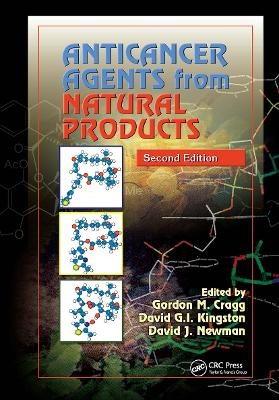
Anticancer Agents from Natural Products
CRC Press (Verlag)
978-1-032-91753-5 (ISBN)
The approach to drug discovery from natural sources has yielded many important new pharmaceuticals inaccessible by other routes. In many cases the isolated natural product may not be an effective drug for any of several reasons, but it nevertheless may become a drug through chemical modification or have a novel pharmacophore for future drug design. In summarizing the status of natural products as cancer chemotherapeutics, Anticancer Agents from Natural Products, Second Edition covers the:
History of each covered drug—a discussion of its mechanism on action, medicinal chemistry, synthesis, and clinical applications
Potential for novel drug discovery through the use of genome mining as well as future developments in anticancer drug discovery
Important biosynthetic approaches to "unnatural" natural products
Anticancer Agents from Natural Products, Second Edition discusses how complex target-oriented synthesis—enabled by historic advances in methodology—has enormously expanded the scope of the possible. This book covers the current clinically used anticancer agents that are either natural products or are clearly derived from natural product leads. It also reviews drug candidates currently in clinical development since many of these will be clinically used drugs in the future.
Examples include the drugs etoposide and teniposide derived from the lead compound podophyllotoxin; numerous analogs derived from taxol; topotecan, derived from camptothecin; and the synthetic clinical candidates, E7389 and HTI-286, developed from the marine leads, halichondrin B and hemiasterlin.
Gordon M. Cragg obtained his undergraduate training in chemistry at Rhodes University, South Africa, and his D. Phil. (organic chemistry) from Oxford University. After two years of postdoctoral research at the University of California, Los Angeles, he returned to South Africa to join the Council for Scientific and Industrial Research. In 1966, he joined the Chemistry Department at the University of South Africa, and transferred to the University of Cape Town in 1972. In 1979, he returned to the US to join the Cancer Research Institute at Arizona State University working with Professor G. R. Pettit. In 1985, he moved to the National Cancer Institute (NCI), National Institutes of Health (NIH) in Bethesda, Maryland, and was appointed Chief of the NCI Natural Products Branch in 1989. He retired in December, 2004, and is currently serving as an NIH Special Volunteer. His major interests lie in the discovery of novel natural product agents for the treatment of cancer and AIDS, with an emphasis on multidisciplinary and international collaboration. He has given over 100 invited talks at conferences in many countries worldwide, and has been awarded NIH Merit Awards for his contributions to the development of the anticancer drug, Taxol (1991), leadership in establishing international collaborative research in biodiversity and natural products drug discovery (2004), and contributions to developing and teaching NIH technology transfer courses (2004). He was President of the American Society of Pharmacognosy in 1998-1999, was elected to Honorary Membership of the Society in 2003, and was named a Fellow of the Society in 2008. In November 2006 he was awarded the William L. Brown Award for Plant Genetic Resources by Missouri Botanical Garden which also named a recently discovered Madagascar plant in his honor, Ludia craggiana, and in April 2010 he was awarded an Honorary Doctorate of Science by his South African alma mater, Rhodes University.
PLANT PRODUCTS: Introduction. Camptothecin and its Analogs. Discovery and Development of the Combretastatins. Homoharringtonine and Related Compounds. Podophyllotoxins and Analogs. Taxol and Its Analogs. The Vinca Alkaloids. MARINE PRODUCTS: The Bryostatins. The Cryptophycins. The Discodermolides. The Dolastatins. Ecteinascidin-743. Aplidin. Kahalalide F. Discovery of E7389. Synthetic Halichondrin Analog.HTI-286. Synthetic Analog of Hemiasterlins. Salinosporamide etc. MICROBIAL PRODUCTS: The Actinomycins. The Anthracyclines. Ansamitocins (Maytansanoids). Benzoquinone Ansamycins. The Bleomycin Group. Biochemical Evaluation of CC1065 Analogs. Epothilone, A Myxobacterial Metabolite. Enediynes Biosyntheses. The Mitomycins. Staurosporines and Related Compounds. Potential for New Compounds from Gene Analyses (Bacterial and Fungal). Environmental DNA. MISCELLANEOUS DEVELOPMENTS: Combinatorial Biosynthesis. Developments and Future Trends.
| Erscheinungsdatum | 16.10.2024 |
|---|---|
| Zusatzinfo | 450 Illustrations, black and white |
| Verlagsort | London |
| Sprache | englisch |
| Maße | 178 x 254 mm |
| Gewicht | 1446 g |
| Themenwelt | Medizin / Pharmazie ► Medizinische Fachgebiete ► Pharmakologie / Pharmakotherapie |
| Naturwissenschaften ► Biologie | |
| Naturwissenschaften ► Chemie | |
| ISBN-10 | 1-032-91753-9 / 1032917539 |
| ISBN-13 | 978-1-032-91753-5 / 9781032917535 |
| Zustand | Neuware |
| Haben Sie eine Frage zum Produkt? |
aus dem Bereich


